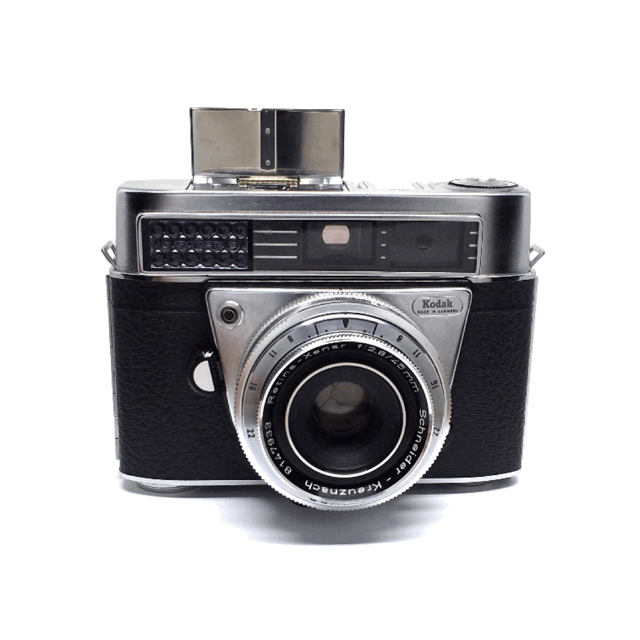Kodak Retina IIF
Die Retina IIF ist zusammen mit einer IIIS eine von zwei Retinas mit Entfernungsmesser, die keine Klappkameras sind wie meine anderen Retinas wie die I, IIa, IIIc und IIIC. Das Besondere an der IIF ist der aufklappbare Blitzreflektor an ihrer Oberseite, der das Licht einer AG-1 Blitzbirne reflektieren soll, die man in eine Fassung vor dem Reflektor stecken kann. Um diese Birnen zu zünden benötigt die IIF (F steht für Flash) eine Knopfzellen-Batterie, die im Boden der Kamera untergebracht ist.
Der Selen- Belichtungsmesser, der sich von 12 bis 1250 ASA einstellen lässt, hingegegen funktioniert ohne Batterie, und bei meiner Kamera arbeitet er sogar recht präzise. Im Gegensatz zu meinen anderen Retinas, bei denen man die Messwerte manuell auf eine Skala am Verschluss übertragen muss, ist der Belichtungsmesser der IIF mit Blende und Verschlusszeit gekoppelt. Die richtige Belichtung sieht man an einer Nadel im Sucher, die man unterhalb des Leuchtrahmens für das 50mm Objektiv zwischen zwei schrägen Marken zentrieren muss.
Hat man sich erst einmal an die Bedienung der Kamera mit ihrem seitlich neben dem Objektiv angebrachten Auslöser gewöhnt, lässt sich mit ihr gut und komfortabel fotografieren. Leider ist die IIF nicht mehr so solide gebaut wie ihre klappbaren Vorgänger. Vieles, was vorher aus Metall war wie zum Beispiel der Rückspulknopf, ist hier aus Plastik, was nicht sehr vertrauenerweckend wirkt.
Über jeden Zweifel erhaben aber ist das Objektiv, ein 2.8/45mm Xenar von Schneider-Kreuznach, ein Vierlinser vom Tessar-Typ, der sich in punkto Abbildungsleistung nicht hinter dem sechslinsigen 2.0/50mm Xenon der III-er-Modelle zu verstecken braucht.

Kodak Retina IIF
The Retina IIF is together with a IIIS one of my two rigid body Retina rangefinder cameras (complementing my Retina I, IIa, IIIc and IIIC folders). Its name "F" derives from the pop-up metal shield on the top plate that reflects the light of an AG-1 flash bulb you can insert in a special slot. To fire this bulb you need a PX-13 battery located in a compartment in the bottom of the camera. In addition to this rather unique contraption the IIF features a cold shoe for electronic or other flashes that are fired via a sync socket located above the shutter release button that is located at front plate of the camera on the right side of the lens.
The selenium exposure meter (adjustable from 12 to 1250 ASA and working like a charm on my IIF) needs no battery and is coupled with the aperture and the shutter speed dial that are situated concentric to the lens barrel. When looking into the viewfinder you see a needle that has to be centered within two marks below the bright lines and the rangefinder patch in order to achieve a proper exposure.
Taking pictures with the IIF is as easy as with a modern camera in manual mode, but the build quality of the IIF lacks the solid all-metal feeling of my other Retinas. Too many parts have been either slimmed down or made of rather flimsy feeling plastic like the rewind knob that is no comparison to the massive metal wheel of the older Retinas.
The lens is a 2.8/45mm Xenar (instead of the 2.0/50mm Xenon of my Retina IIIc and IIIC) but although it is focused by turning the front lens the pictures it takes are superb.